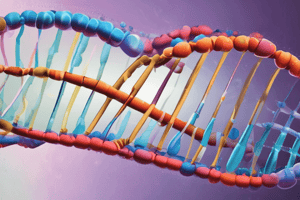Podcast
Questions and Answers
What triggers the initiation of DNA replication at the origin of replication?
What triggers the initiation of DNA replication at the origin of replication?
- Synthesis of RNA primers
- The formation of Okazaki fragments
- Recognition by initiator proteins (correct)
- The action of proofreading enzymes
Which enzyme is responsible for unwinding the DNA double helix during replication?
Which enzyme is responsible for unwinding the DNA double helix during replication?
- DNA Polymerase III
- Single-Strand Binding Proteins
- Helicase (correct)
- Primase
In which direction is the leading strand synthesized during DNA replication?
In which direction is the leading strand synthesized during DNA replication?
- In Okazaki fragments
- 3' to 5'
- Randomly without direction
- 5' to 3' (correct)
What is the primary function of Primase during DNA replication?
What is the primary function of Primase during DNA replication?
Which DNA polymerase is primarily responsible for adding nucleotides during DNA synthesis in prokaryotes?
Which DNA polymerase is primarily responsible for adding nucleotides during DNA synthesis in prokaryotes?
What is the main characteristic of the lagging strand during DNA replication?
What is the main characteristic of the lagging strand during DNA replication?
What unique ability do most DNA polymerases possess during DNA replication?
What unique ability do most DNA polymerases possess during DNA replication?
How do single-strand binding proteins (SSBs) function during DNA replication?
How do single-strand binding proteins (SSBs) function during DNA replication?
Flashcards
Origin of Replication
Origin of Replication
Specific sites on DNA where replication begins that are recognized by initiator proteins.
Replication Bubble
Replication Bubble
A region of DNA that is unwound, forming a bubble with two replication forks.
Helicase
Helicase
The enzyme that unwinds the double helix, allowing access to the template strands.
Single-strand Binding Proteins (SSBs)
Single-strand Binding Proteins (SSBs)
Signup and view all the flashcards
Primase
Primase
Signup and view all the flashcards
Leading Strand
Leading Strand
Signup and view all the flashcards
Lagging Strand
Lagging Strand
Signup and view all the flashcards
DNA Polymerase Role
DNA Polymerase Role
Signup and view all the flashcards
Study Notes
DNA Replication
Initiation of Replication
- Origin of Replication: Specific sites on DNA where replication begins, recognized by initiator proteins.
- Formation of Replication Bubble:
- DNA unwinds, creating a bubble with two replication forks.
- Helicase enzyme unwinds the DNA double helix.
- Single-Strand Binding Proteins (SSBs): Stabilize unwound single strands, preventing them from re-annealing.
- Primase: Synthesizes short RNA primers complementary to the DNA template, necessary for DNA polymerase to start.
- Leading and Lagging Strands:
- Leading strand synthesized continuously in the direction of the replication fork.
- Lagging strand synthesized discontinuously in short fragments (Okazaki fragments) away from the fork.
DNA Polymerase Function
- Role of DNA Polymerase: Enzymes that synthesize new DNA strands by adding nucleotides to the growing chain.
- Types of DNA Polymerases:
- DNA Polymerase III: Main enzyme for DNA synthesis in prokaryotes, adds nucleotides at high speed.
- DNA Polymerase I: Removes RNA primers and replaces them with DNA in prokaryotes.
- Key Functions:
- Nucleotide Addition: Can only add nucleotides to the 3' end of a growing strand, requiring an existing strand to extend.
- Proofreading Ability: Many DNA polymerases have 3' to 5' exonuclease activity, allowing them to correct errors during replication.
- Processivity: DNA polymerases have varying levels of processivity, indicating how many nucleotides they can add before dissociating from the template.
- Overall Direction of Synthesis: DNA is synthesized in a 5' to 3' direction.
DNA Replication
Initiation of Replication
- Origin of Replication: Specific DNA sites recognized by initiator proteins to begin the replication process.
- Formation of Replication Bubble: Occurs when DNA unwinds, forming a bubble with two replication forks.
- Helicase: Enzyme responsible for unwinding the DNA double helix, enabling access to the template strands.
- Single-Strand Binding Proteins (SSBs): Stabilize and protect unwound single DNA strands from re-annealing during replication.
- Primase: Synthesizes short RNA primers complementary to the DNA template, crucial for the initiation of DNA synthesis.
- Leading Strands: Synthesized continuously in the same direction as the movement of the replication fork.
- Lagging Strands: Synthesized discontinuously as short fragments (Okazaki fragments) in the opposite direction of the fork movement.
DNA Polymerase Function
- DNA Polymerase Role: Enzymes that facilitate the synthesis of new DNA strands by adding nucleotides to the growing chain.
- Types of DNA Polymerases:
- DNA Polymerase III: The primary enzyme in prokaryotes, characterized by high-speed nucleotide addition during DNA synthesis.
- DNA Polymerase I: Functions to remove RNA primers and replace them with DNA in prokaryotic cells.
- Key Functions:
- Nucleotide Addition: Only adds nucleotides to the 3' end of an existing strand, necessitating a template to extend from.
- Proofreading Ability: Many DNA polymerases possess 3' to 5' exonuclease activity, enabling them to identify and correct replication errors.
- Processivity: Refers to the number of nucleotides added before the polymerase dissociates from the DNA template, varying across different polymerases.
- Direction of Synthesis: DNA strands are synthesized in a 5' to 3' direction, consistent across all organisms.
Studying That Suits You
Use AI to generate personalized quizzes and flashcards to suit your learning preferences.




